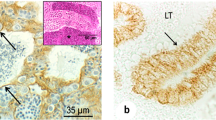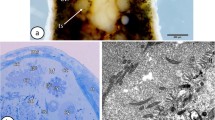Summary
Three different cell types are the most frequent elements of the epidermis of the neotenic axolotl: (1) the common epidermal cells are small and multiform. They show bundles of tonofilaments (figures ofEberth) in the stratum basale. (2) The big Leydig cells contain numerous gross granules and a special network in the peripheral cytoplasm (Langerhans net). (3) The cover cells forming the outer layer of the epidermis possess a striking mucin zone in the apical cytoplasm.
Similar content being viewed by others

References
D. E. Kelly, Anat. Rec.154, 685 (1966).
Author information
Authors and Affiliations
Rights and permissions
About this article
Cite this article
Fährmann, W. Die licht- und sublichtmikroskopische Morphologie der Epidermis des neotenen Axolotls (Siredon mexicanum Shaw). Experientia 24, 708–709 (1968). https://doi.org/10.1007/BF02138329
Published:
Issue Date:
DOI: https://doi.org/10.1007/BF02138329



